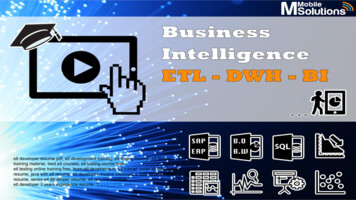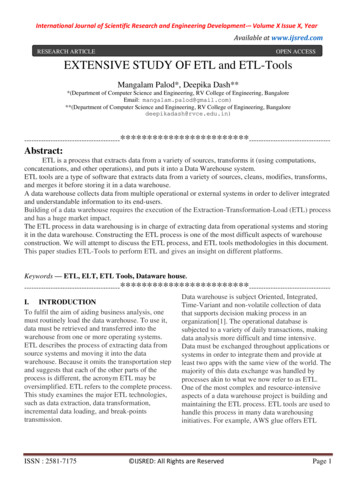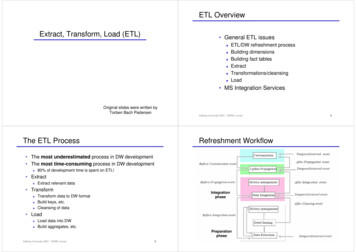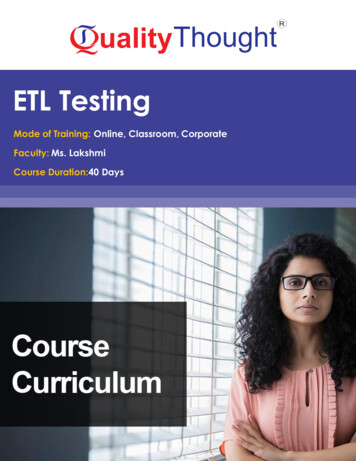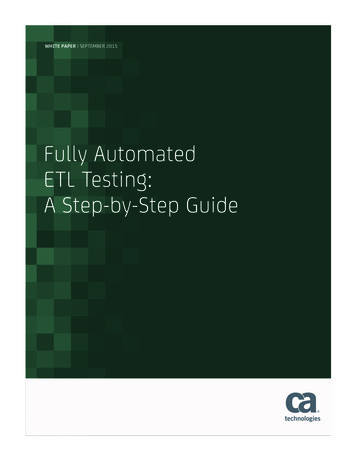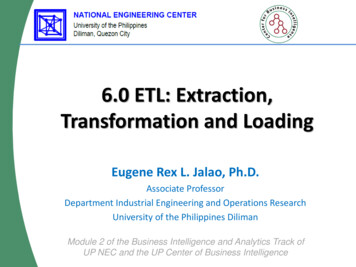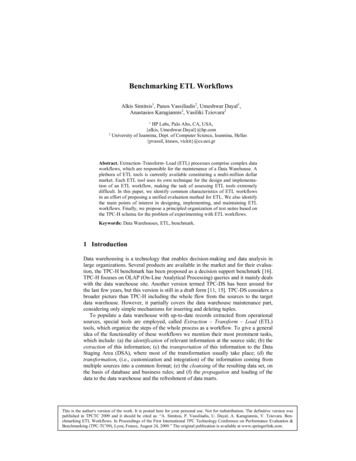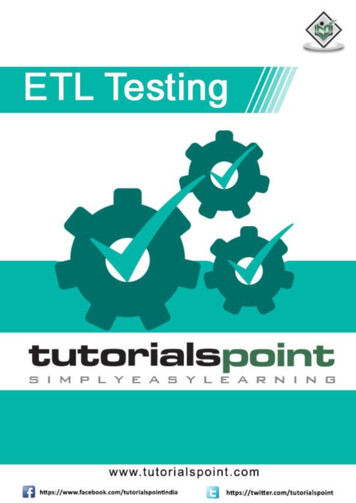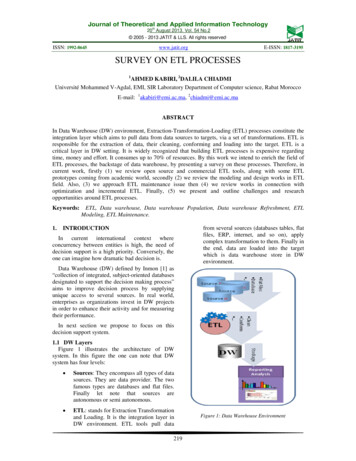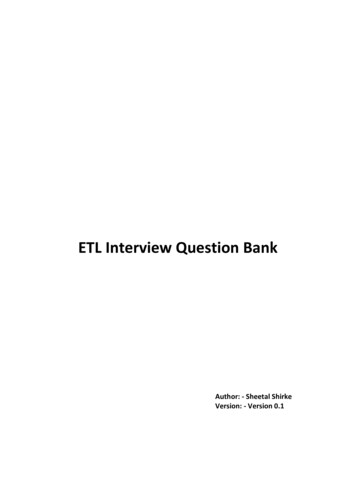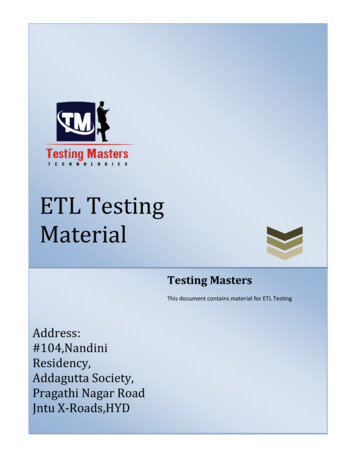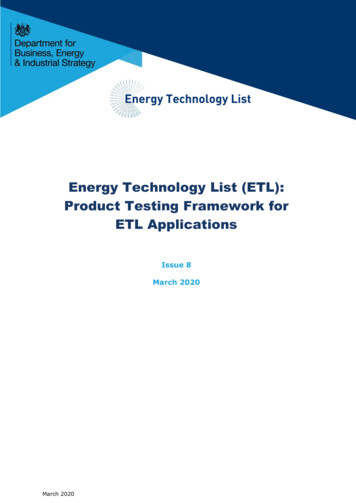
Transcription
Energy Technology List (ETL):Product Testing Framework forETL ApplicationsIssue 8March 2020March 2020
ETL Testing Programme – Product Testing FrameworkCONTENTSSECTIONPage1INTRODUCTION32PRODUCT TESTING AND VERIFICATION METHODS33GENERAL REQUIREMENTS FOR PRODUCT TESTING74REPRESENTATIVE TESTING85DETERMINING THE TYPE OF ACCEPTABLE TEST REPORTPage 2 of 12March 202011
ETL Testing Programme – Framework for Product Testing Requirements1INTRODUCTIONIn most ETL technology categories there is a requirement for themanufacturer/supplier to provide testing documentation of the product’sperformance when making a new ETL product application. The test document willbe reviewed by the assessment team against the criteria for this product, alongwith other supporting documentation submitted by the manufacturer with theapplication.This guidance note sets out the testing requirements that apply in the differenttechnologies and includes details of how representative testing can be used toreduce the number of separate reports required for products within a range.Some sub-technologies require no substantiation of performance as part of theapplication process, these are: Portable Monitoring and Targeting Equipment; Heat Recovery from Condensate and Boiler Blowdown and HeatingManagement Controllers (Boiler Equipment); Master Controllers (Compressed Air Equipment); Building Environment Zone Controls (HVAC Equipment); Variable Speed Drives; and Curtains, Blinds, Doors and Covers for Refrigerated Display Cabinets,Evaporative Condensers and Refrigeration System Controls (RefrigerationEquipment).“Unlisted” technologies do not require product applications to the ETL forassessment, these are: CHP & Absorption and Other Heat Driven Cooling & Heating Equipment; Lighting Controls; Efficient White Lighting Units; Pipework Insulation; Air to Air Heat Pumps, Split, Multi-Split and VRF; and Automatic Monitoring and Targeting Sub-metering Systems.More information about these categories can be found in the Key Information forManufacturers factsheet.2PRODUCT TESTING AND VERIFICATION METHODSThere are seven routes to providing valid test evidence for your product application.Table 1 details which routes are available for which technology:1. In-house testing: self-certified.2. In-house testing: verified by an independent body. A representative sampleof the test data is verified by an independent body. The verifier should alsohave seen an example of testing take place in the lab and be satisfied thattest conditions meet the ETL criteria test standard for that technologycategory.Page 3 of 12March 2020
ETL Testing Programme – Framework for Product Testing Requirements3. Witnessed testing. Products are tested in the presence of a witness from anindependent body who should sign to verify the accuracy of the data on thetest report and confirm that the test was carried out in accordance with thetest standard requirements.4. Independent testing. Products are tested in an independent laboratory that isUKAS accredited or accredited by an accreditation body under ILAC orequivalent.5. Acceptance tests or field trials. Only used where laboratory testing is notpractical due to product size or lack of suitable facilities.6. Design calculations: representative testing. Used to reduce the cost of testingproducts for the same basic design.Note that if a manufacturer’s own laboratory is certified to BS EN ISO/IEC 17025the requirements for self-certified products can be followed. There is no need forverified in-house testing, witnessing testing or independent testing1.Definitions Accredited Test Laboratory: A laboratory that has been accredited by theUnited Kingdom Accreditation Scheme (UKAS) or other equivalent nationalaccreditation body recognised via the European Co-operation forAccreditation, the International Accreditation Forum, or the InternationalLaboratory Accreditation Co-operation (ILAC) agreements to undertake thatparticular type of test. A list of laboratories that have been accredited byUKAS for testing and calibration is published at: http://www.ukas.org/. Listsof national accreditation bodies in other countries which may be equivalentcan be found at: http://www.european-accreditation.org/ http://www.iaf.nu/http://www.ilac.org/ Scope of Accreditation: The document that defines which particular types oftest a laboratory is accredited to undertake. Independent bodies / Witnesses: e.g. independent laboratories (includingaccredited test laboratories) and independent consultants (with appropriatequalifications, experience and PI insurance). They are expected todemonstrate their qualifications (e.g. engineer), knowledge (regulations andpolicy context) and experience (several years in the field for thattechnology). For example, relevant experience may include: Experience of product testing/witness testing and validation of systems inthat technology to relevant standards; Technical project work providing technical support in the technology; Undertaking condition and performance surveys; Monitoring compliance to regulatory systems in industry; Development and R&D related work in the field.1Some products might still require an independent verification or witnessed assessment in order to be eligible tobe placed on the market (e.g. under the scope of the PED, Pressure Equipment Directive, or some boilers).Page 4 of 12March 2020
ETL Testing Programme – Framework for Product Testing RequirementsAcceptable Product Testing & Verification Methods per Technology Type (table 1)Please note that there are a few technologies where test evidence is not required – see Section 1(Introduction) of this document. In all the technologies below, test evidence is required.TestingVerified by an independent bodyWitnessed TestingIndependent TestingAcceptance Tests or Field TrialsRoute12345Air-to-air energy recovery devices * *Testing & Verification MethodTechnology &Sub-technologyBiomass Boilers6 2* Condensing Economisers Flue Gas Economisers Gas Fired Condensing Water Heaters Hot Water Boilers Retrofit Burner Control Systems Steam Boilers Desiccant Air Dryers with Energy Saving Controls Refrigerated Air Dryers with Energy SavingControls Air to water heat pumps Air Source: Gas engine driven split and multi-split Packaged air to air heat pumps (rooftop) Air to domestic hot water heat pumps Water or brine to water heat pumps Heat Pump DehumidifiersBoiler Equipment 3 Heat Pump Driven Air Curtains Water to air heat pumps, split, multi-split and VRF HVACActive Chilled BeamsClose Control Air Conditioning EquipmentEvaporative Air Coolers * Test reports must be prepared by, or verified by, an independent accredited test laboratory23 Burners with ControlsHeat PumpsCompressedAirEquipmentRepresentative TestingSelf-certifiedIn-house testingRepresentative Testing (Ecodesign)DesignCalculationsCategory 2 & 3 onlyCategory 1 & 2 above 400kW and Category 3 above 900kWPage 5 of 12March 2020
ETL Testing Programme – Framework for Product Testing RequirementsAcceptable Product Testing & Verification Methods per Technology Type continued (table 1)TestingWitnessed TestingIndependent Testing1234High speed hand air dryers Technology &Sub-technologyWaste Heat toElectricity ConversionEquipmentRefrigeration EquipmentRadiant &Warm AirHeatersMotors&DrivesWhite LED Lighting Modules for Backlit Illuminated Signs56 Converter-fed Motors Line Operated AC Motors Radiant heating equipment Warm air heating equipment Air blast coolers Air cooled condensing units Automated Permanent Refrigerant Leak DetectionSystem Professional refrigerated storage cabinets Refrigerated display cabinets Cellar cooling equipmentPackaged chillers Refrigeration compressors Solar Thermal Systems Uninterruptible Power Supplies ** **Organic Rankine Cycle Heat Recovery EquipmentSaturated Steam to Electricity Conversion Equipment ** The acceptance tests or field trials must be witnessed by an independent body*** See Method B in the Organic Rankine Cycle Heat Recovery Equipment criteriaPage 6 of 12March 2020Representative TestingVerified by an independent bodyRouteTesting & Verification MethodAcceptance Tests or Field TrialsSelf-certifiedIn-house testingRepresentative Testing (Ecodesign)DesignCalculations ***
ETL Testing Programme – Framework for Product Testing RequirementsConditional Requirements on Choosing Certain Product Testing and Verification RoutesManufacturers may select any of the product testing options in “table 1”. However, if themanufacturer opts for self-certified or witness testing, there are 5 conditions which need to be metand evidenced by declarations and supporting documents (table 2). Independent laboratoriesaccredited by UKAS, or by another accreditation body under ILAC, operating a BS EN ISO/IEC 17025system, are considered to be competent.3GENERAL REQUIREMENTS FOR PRODUCT TESTINGManufacturers/suppliers may select any of the product testing options indicated in Table 1provided:1. The test facility complies with the minimum specifications outlined in the teststandards and is able to maintain the required test conditions throughout thespecified test period or cycle (including any required pre-test stabilisation period).2. The test measuring equipment meets the requirement for measurement accuracyand uncertainty in the specified test standards/methods, has been calibrated by alaboratory accredited by UKAS/ILAC (or equivalent body) and its calibration istraceable back to national measurements standards.3. Product testing is undertaken by competent personnel with training and experiencein the use of the test facilities, who can accurately and clearly record test data andproduce test reports in accordance with the test standard(s) specified in the criteria.4. A recognised quality management system is in place ensuring and maintaining thequality of the test facilities, procedures and reports; and ensuring document controlof the products tested including detailed measurement data, observations and testreports.5. Appropriate quality assurance procedures are adopted to ensure the accuracy andrepeatability of the test results including checking the calibration of measuringequipment and re-testing of a representative sample of products every 2-3 years.For self-certified and witnessing testing routes, applicants will be required to confirm thatthe selected product testing option meets these requirements by submitting thedeclarations and supporting documents set out in Table 2. Independent laboratories thathave been accredited by UKAS/ILAC (or equivalent bodies) are considered to be competentto test products using the test standards named in their scope of accreditation under BS ENISO/IEC 17025:2005.Table 2: Conditional requirements for self-certified and witness testing routesConditions /RequirementsTest Facilities:complies with theminimumspecification in thetest standard andthroughout the test.Self-certifiedWitness TestingDeclaration by themanufacturer against therequirement.Declaration by anindependent party whererequired in the applicationchecklist, that arepresentative sample ofDeclaration by the witnessagainst the requirement.Declaration by the witnessthat the test was observedin line with the teststandard and verification ofthe test data.Page 7 of 12March 2020
ETL Testing Programme – Framework for Product Testing RequirementsMeasuringEquipment: meetsthe accuracyrequirements fromthe test standards.Has been calibratedvia accreditedlaboratory orthrough tracing backto measurementstandards.TechnicalCompetence:competent personnelwith training andexperience who canaccurately recordtest data andproduce test results.QualityManagementSystem: ensuringand maintainingquality of facilities,procedures andreports.Quality AssuranceProcedures:ensuring theaccuracy andrepeatability of testresults, includingcalibration andrepresentativesample testing.the test data has beencross-checked and verifiedby the independent body.Declaration by themanufacturer against thecalibration requirement,including dates of the lastcalibration and the methodused.Test person name,signature on the testreportsDeclaration by theindependent body orwitness that the calibrationrequirement was verified.Details required of thewitnesses’ competence toact as a witness, if notrecently submitted onanother application.Details of the QMS used to ensure quality of testingprocedure e.g. ISO 9001, ISO 17025 certificate.Declaration by themanufacturer against therequirement.Summary details of theprocedure used to verifythe accuracy of test results.Declaration by the witnessthat appropriate QAprocedures were appliedduring testing.Summary details of theprocedure used to verifythe accuracy of test results.Notes:Detailed test reports should contain the name of the accredited laboratory that calibratedthe measuring equipment, or an explanation of how calibration is otherwise traceable tonational measurements standards as defined in Section 5.6 of BS EN ISO/IEC 17025:2005.4REPRESENTATIVE TESTINGIn some technology categories (see Table 1) representative testing can be used to reducethe number of individual products that must be tested before a group of related productscan be listed on the ETL.Page 8 of 12March 2020
ETL Testing Programme – Framework for Product Testing RequirementsRepresentative models must be selected in accordance with the rules set out below and inTable 3, unless the ETL criteria say otherwise, in which case the criteria rulesapply:1. Product Range: the manufacturer shall define a range of products, which are allvariants of the same design. For example for packaged chillers they would all usethe same refrigerant, have the same compressors and fit within the same productcategory.2. Product Group: within the range, the manufacturer shall define the product groups,with each group having similar design characteristics and efficiencies.Once the range and then the products groupings within it have been defined arepresentative sample of models are tested: For each range, a minimum of at least two models shall be testedFor each group, within the range,o a model from the lowest quartile of predicted performance shall be testedo the performance of each model in the group shall be predicted using avalidated mathematical modelWith the following exception:The following 17 sub-technology groups have different representative testing requirementsas they are covered by the Ecodesign Directive: Air to air energy recoveryAir to domestic hot water heat pumpsAir to water heat pumpsHeat pump driven air curtainsPackaged air to air heat pumps (rooftop)Water to air heat pumps, split, multi-split and VRFWater or brine to water heat pumpsGas fired condensing water heatersHot water boilersRadiant heating equipmentWarm-air heating equipmentConverter fed motorsLine operated AC motorsAir cooled condensing unitsPackaged chillersProfessional refrigerated storage cabinetsRefrigerated display cabinetsThe requirements for these sub-technology groups is:1. A full test report is required for at least one representative model per range. TheEcodesign technical data is required for the other products in the range (where nofurther test reports are provided for these products).2. A summary table of all the key data which is included in the technical data sheet ordata fiche required by Ecodesign for each of the products within the application.3. Details of the extrapolation / interpolation method or other calculation model thathas been used to determine calculated results.4. A description of how any calculation method or model has been validated (e.g.through comparison of product test reports with the outputs of the calculationmodel).Page 9 of 12March 2020
ETL Testing Programme – Framework for Product Testing RequirementsTable 3: Standard rules for selecting representative models for product testingCircumstancesVariation between ModelsSelection RuleVariations orcosmetic changesFor example, in the product exterior orinternal layout, that do not materiallychange its constructional design,functionality or affect its performancespecification.Any model may be therepresentative model.DifferentconstructionaldesignFor example, in terms of materialsspecification like the type ofsubcomponents and subassemblies ons oroperation modesFor example, at the test points set out inthe criteria.These products may bein the same range, butshould be placed indifferent groups.Different productratingFor example, expressed in terms of kW orelectrical power input/output, thermalinput/output or maximum heating orcooling capacity.Modifications andenhancementsShould not affect product performance oralter its constructional design, basicfunctionality or mode of operation at thetest points in the criteria.Differences need to beexplained and productswith modifications andenhancements clearlyidentified. These canbe in the same range /groups as otherproducts.ApplicationManufacturers are advised to separate out their product applications, with each applicationcovering a specific range. Each application shall include the:1. Design data that demonstrates the products are of similar design2. Details of how the representative sample of products was chosen3. Test reportsIf the representative models are already on the ETL then the test data for therepresentative model needs to be resubmitted with each new application.Removal If a manufacturer voluntarily removes a representative model from the ETL, theother products linked with that representative model will normally be removedunless alternative test data can be submitted.If any product submitted under the representative testing rules is later found to notmeet the performance criteria when independently tested, then the entire productgroup will normally be removed from the ETL.Page 10 of 12March 2020
ETL Testing Programme – Framework for Product Testing Requirements5DETERMINING THE TYPE OF ACCEPTABLE TEST REPORTA test report shall be prepared that conforms to the essential requirements of section 5.10of 17025.For some product testing options summary test reports can be accepted but for othersdetailed test reports must be submitted. The requirements are set forth in Table 4 below.Table 4: Type of report that must be submitted by product testing optionProduct Testing OptionVolume of ApplicationsIn-house Testing First 2 product applicationswithin a product rangeSubsequent applicationswithin the same productrangeWitnessed Testing N/AVerification mmary orDetailedSummarySummary orDetailedSummary orDetailedIndependent Testing N/AAcceptance Tests or Field N/ATrialsRepresentative Testing First 2 representativemodels for a product rangeSubsequent representativemodels for a product rangeDetailedDetailedSummary orDetailedSummaryWhat Constitutes a Detailed and Summary Test Report?Table 5 below outlines the typical contents of a detailed test report and should be used tocheck whether existing test reports are of sufficient quality. A summary test report shouldcontain the same basic information as a detailed test report. However detailed descriptions,analyses and discussions may be replaced with references to other, related documents.Page 11 of 12March 2020
ETL Testing Programme – Framework for Product Testing RequirementsTable 5: Typical contents of a detailed and summary test reportDetailed Test ReportSummary TestReportScope: details of product tested (name & model), full reference to teststandards used and confirmation of applicable QA procedures /management systemSame asDetailed TestReportIntroduction: location and date of testing and confirmation of whetherthe test facilities used are permanently under control of the testlaboratory.Same asDetailed TestReportProducts being tested: product identification data, product installation,configuration and commissioning information and details of controlsettings used during the test. Details of the product’s condition at thestart/end of testing and any modifications made to the product duringtesting.Same asDetailed TestReportTest procedures: 1) a description of how each test was conducted,test standard used and any deviations; 2) test rig schematic; and 3) alist of measuring equipment.Point 1)Test results: 1) a table showing the average value of all measuredparameters including maximum and minimum values recorded; 2)details of any calculations and corrections made; 3) a discussion ofthe test results, including any observations made during the tests.Points 1) & 2)Appendices: 1) ISO9001 / ISO 17025; and 2) calibration certificates4;3) details of procedures used to cross check accuracy of results; 4)measurement data collected during testing, in Excel format.Points 1) to 3)Representative testing: an explanation of the methodology used togroup and select products for testing.Same asDetailed TestReport4Detailed test reports should contain the name of the accredited laboratory that calibrated the measuring equipment or anexplanation of how calibration is otherwise traceable to national measurement standards as defined in section 5.6 of 17025Page 12 of 12March 2020
ETL Testing Programme - Framework for Product Testing Requirements Page 3 of 12 March 2020 1 INTRODUCTION In most ETL technology categories there is a requirement for the manufacturer/supplier to provide testing documentation of the product's performance when making a new ETL product application. The test document will
